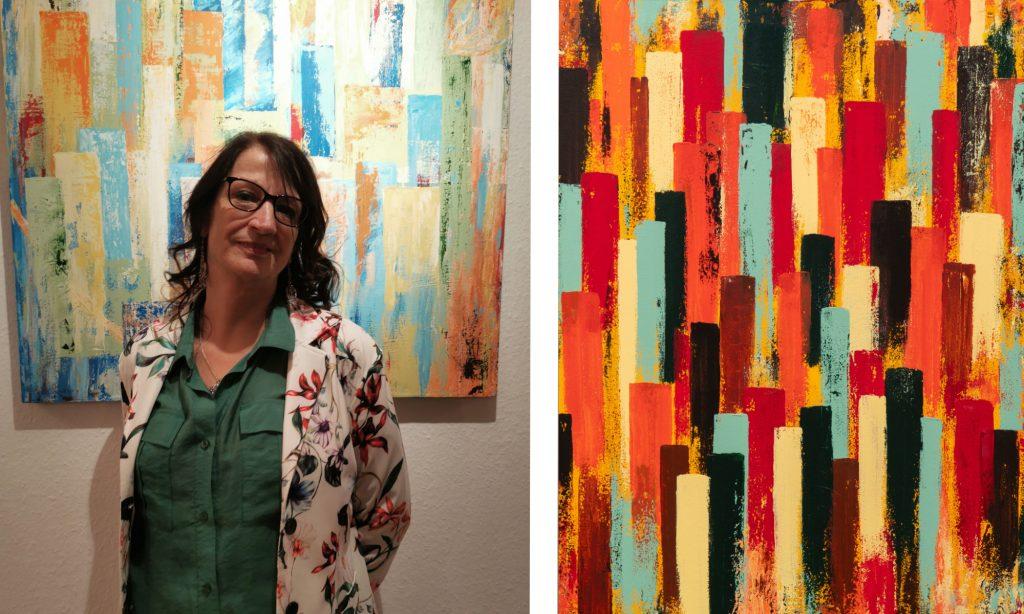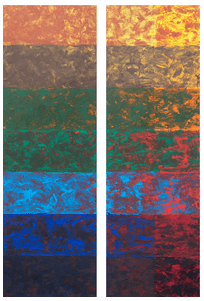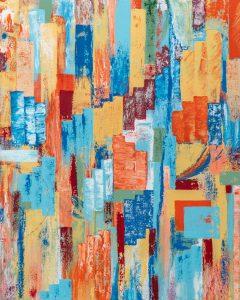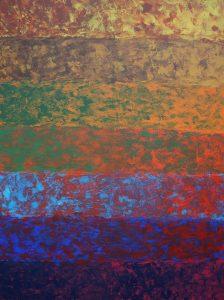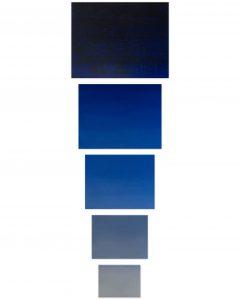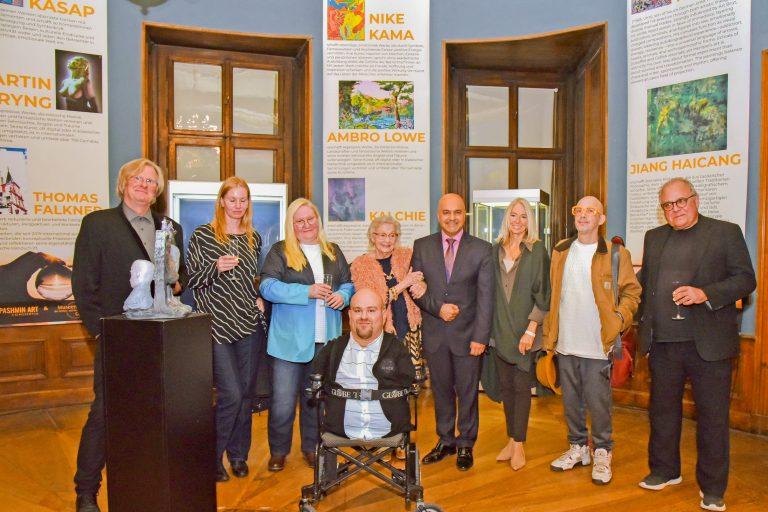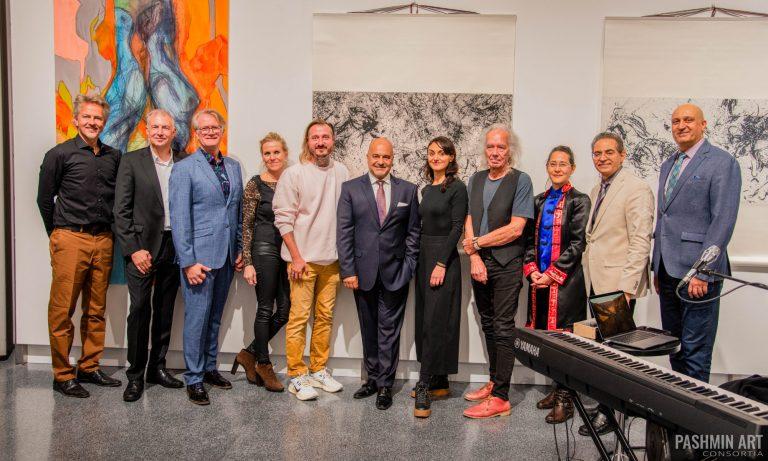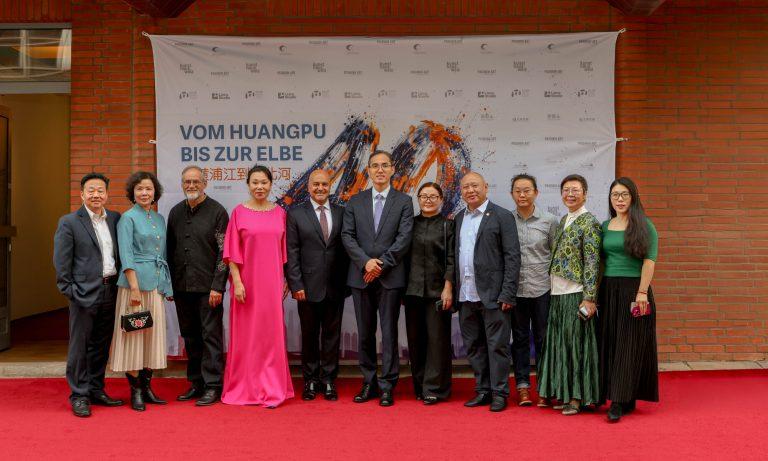Jolanda Keeris, an artist based in Veldhoven, Netherlands, imbues her canvases with a profound sensitivity born from a personal journey. A passionate former teacher, her path shifted due to an autoimmune disease, leading her to art through a painting class suggested by her daughter. She refined her technique under Hanneke van der Zanden, while her home studio practice remained intuitive, guided by color and personal resonance. Keeris’s oeuvre, blending personal inspirations and commissioned works, aims to articulate complex stories and emotions. Her art deeply engages with gradations, layers, densities, and nuanced transitions, strongly embodying the concept of fuzzy logic.
Developed by Lotfi Zadeh, fuzzy logic mimics human decision-making by considering degrees of truth between absolute binaries (0 and 1), enabling nuanced and flexible interpretations. This reasoning parallels Keeris’s artistic approach, which avoids rigid distinctions, embracing the fluidity and complexity inherent in life’s spectrums. Her intuitive, color-driven practice, with its emphasis on continuous transitions, inherently embodies Zadeh’s concept of partial truth. Keeris’s canvases become a stage for exploring membership degrees, linguistic variables, and fuzzy rules, translating abstract mathematical frameworks into tangible emotional and atmospheric expressions. Her art doesn’t just describe fuzzy concepts; it performs them, making abstract mathematical ideas tangible and emotionally resonant. This review explores artworks exhibited in 2025 at Greiz Castle Museums (Museums of the Castle Town and Royal Capital of Greiz / Museen der Schloss- und Residenzstadt Greiz) in Germany and Pashmin Art Gallery (Hamburg). Through the interpretative lens of fuzzy logic, we highlight key themes and artistic expressions, emphasizing the nuances, uncertainties, and fluid boundaries inherent in contemporary art.
Carnaval in de Stad: Fuzzy Chroma of Celebration
“Carnaval in de Stad” (100 x 120 cm) exemplifies fuzzy logic in a dynamic composition. Its “dynamic interplay of reds, blues, yellows, and greens” evokes “joyful chaos and an exuberant spirit where boundaries blur.” This directly relates to fuzzy sets of chromatic identity. Instead of strict color boundaries, a patch of color might have a high membership degree in ‘red’ (e.g., 0.9), a moderate degree in ‘orange’ (0.6), and even a low but non-zero degree in ‘yellow’ (0.2). This continuous color spectrum creates “joyful chaos,” allowing the eye to perceive a vibrant confluence rather than distinct blocks.
“Textured layering and rhythmic brushwork” contribute to fuzzy spatial relationships. The perception of foreground/background is not absolute; a layer might have a 0.7 membership in ‘foreground’ and 0.3 in ‘middle ground,’ creating fluid depth, mirroring how “communal energy thrives” and “boundaries blur” in a real carnival. “Transitions that suggest rather than define” are the essence of fuzzy inference, where conclusions (festivity) arise from imprecise, overlapping premises (color/texture blends).
De Favelas in Rio de Janeiro: Nuanced Narratives of Liveliness and Life
In “De Favelas in Rio de Janeiro” (70 x 90 cm), Keeris’s “energetic brushstrokes and intense color contrasts” depict “complexity and vibrancy,” resonating with fuzzy logic’s capacity to handle complex, multi-faceted realities. “Rich reds, yellows, and contrasting dark hues” create a fuzzy linguistic variable of ‘intensity’ or ‘liveliness.’ A specific area might have high membership in ‘liveliness’ (0.9), moderate in ‘socio-economic struggle’ (0.6), and low but present in ‘hope’ (0.2). These overlapping degrees of truth convey a “powerful visual narrative” echoing “both liveliness and the intricate socio-cultural dynamics of favela life” without reducing it to binaries. The “nuanced interpretation” stems from this fuzzy modeling of complex themes, where aspects exist in varying degrees of presence.
Connected: Harmony Through Fuzzy Interconnectedness
“Connected” (120 x 160 cm) profoundly illustrates fuzzy set theory in harmony and interaction. “Structured horizontal bands” transitioning “subtly from warm, earthy hues to deeper, cooler tones” embody fuzzy boundaries between color temperature sets. Instead of a sharp line, there’s a gradual change. A band might be 0.9 ‘warm’ at one end, shifting through 0.5 ‘warm’/0.5 ‘cool’ in the middle, to 0.9 ‘cool’ at the other. This “harmonious interaction without strict boundaries” defines a fuzzy transition, allowing for “interconnectedness and continuity.”
“Fuzzy gradations of color and textural layers” imply that membership in conceptual fuzzy sets like ‘unity’ or ‘diversity’ is not absolute. An area might have high membership in ‘unity’ (due to seamless transition) while also moderate in ‘diversity’ (due to subtle variations). This prompts viewers to “contemplate nuanced balances and transitions,” which fuzzy logic enables – understanding systems where variables are continuous and relationships are not strictly binary.
De Blauwe Stad: Fuzzy Ambiance of Urban Tranquility
“De Blauwe Stad” (90 x 90 cm) exemplifies fuzzy logic conveying atmospheric and emotional states through nuanced visual language. Its “nuanced palette dominated by gradations of blue, accented with warm and neutral tones,” creates a fuzzy set of ‘blueness’ or ‘tranquility.’ Different shades possess varying degrees of membership within the overarching ‘blue’ concept, from pale (low intensity) to deep indigo (high intensity).
“Geometric, vertical arrangements” that “evoke fuzzy boundaries of cityscapes” show how structured elements can be fuzzy. Edges of buildings might merge or overlap due to texture, light, or blending, giving them a degree of membership in both ‘distinct shape’ and ‘blended background.’ This “spectrum-like approach” captures “the subtle interplay of calm and structure amid urban complexity,” where ‘calm’ and ‘structure’ coexist in varying degrees, mediated by the fuzzy nature of visual components.
Connected in 2: Duality and Transformation Through Fuzzy Aggregation
The diptych “Connected in 2” (Diptych, each panel 120 x 40 cm) explores duality and transformation via fuzzy aggregation and defuzzification processes. “Vibrant interplays of color and texture” where “warm and cool hues merge in structured yet fuzzy layers” represent aggregation of fuzzy sets. The combination doesn’t yield a crisp ‘neutral’; instead, it creates areas with degrees of membership in both, resulting in a nuanced blend, mirroring the complexities of dualities.
“Transitioning from ethereal at the top to denser textures at the bottom” can be seen as a fuzzy rule system for interpreting depth or material density:
- If texture is light and color is ethereal then density is low
- If texture is dense and color is deep then density is high
Intermediate areas would have intermediate degrees of membership in ‘low density’ and ‘high density’ sets. This “fluid coexistence of seemingly opposite forces” parallels fuzzy logic’s ability to handle contradictions and paradoxes by allowing elements to partially belong to opposing categories. Unity emerges not from eliminating contrasts, but from their nuanced, layered intermingling.
Daughter: Fuzzy Unfolding of Identity
“Daughter” (Triptych, each panel 30 x 30 cm) is a compelling narrative of identity formation as a continuous, fuzzy process. “Shifting negative spaces and evolving colors, moving from obscurity to clarity,” illustrates a fuzzy state transition. ‘Identity’ isn’t binary; it’s a gradual unfolding. An initial panel might represent low membership in ‘clarity of identity’ and high in ‘obscurity,’ progressively shifting to high ‘clarity’ and low ‘obscurity.’
“Richly textured brushwork and intensified colors” contribute to the fuzzy representation of identity. Texture itself can be a linguistic variable (‘smoothness’ or ‘roughness’) with varying degrees, reflecting growth complexities. This “flexible understanding of identity formation” resonates deeply with fuzzy logic’s capacity to model processes that are gradual, non-linear, and inherently uncertain, much like human development.
When viewed right to left, “Daughter” narrates a journey from obscurity to self-awareness. Deep violet negative space gradually reveals a defined, vibrant silhouette, signifying movement from half-silence to expression. Bold, gestural strokes build complexity within the face, symbolizing identity growth and emotional depth. As the background lightens, the composition emphasizes themes of emerging individuality and vibrant life. This progression embodies a path toward self-actualization, shaped by experiences and emotions. The dynamic interplay between form and dissolution, color and emptiness, renders “Daughter” a poetic reflection on growth, identity formation, and the rich evolution of selfhood over time.

Revolution of Climate Change: Addressing Urgency with Fuzzy Precision
“Revolution of Climate Change” (40 x 50 cm) powerfully demonstrates fuzzy logic’s application in conveying complex societal issues and uncertainty. “Nuanced gradations of blues” form fuzzy sets representing the severity or progression of climate change. Instead of stark binaries, blues subtly shift, implying a continuum of states. A lighter blue might have high membership in ‘early warning’ (0.8) and low in ‘crisis’ (0.1), while a deeper blue might reverse those memberships.
This “structured yet fluid gradations” allows the painting to “visually communicate the pressing, complex nature of climate issues without relying on stark contrasts.” It embodies fuzzy logic’s capability to address uncertainty and nuanced interpretations—the nature of climate science and its projections. “Highlighting both urgency and adaptability” speaks to fuzzy rules for decision-making under uncertainty:
- If climate_state is urgent then response is adaptable_action.
The painting becomes a visual metaphor for the intrinsically fuzzy nature of environmental challenges, where clear-cut solutions are rare and understanding requires embracing shades of grey.
Conclusion: The Art of Partial Truths
Jolanda Keeris’s art, through its deliberate use of gradations, layers, and fluid transitions, offers a compelling visual vocabulary for fuzzy logic. Her oeuvre performs fuzzy concepts, making abstract mathematical ideas tangible and emotionally resonant. By embracing partial truths and degrees of membership, Keeris’s work provides a nuanced, flexible, and profound commentary on the continuous flux of life and the intricate interconnectedness of our experiences. Her art celebrates the rich complexity of fuzzy reality, found in the spaces between traditional certainties.
© Copyright of the text belongs to Dr. Davood Khazaie
LINKS:
